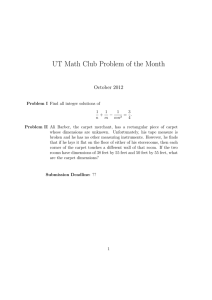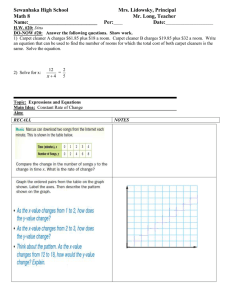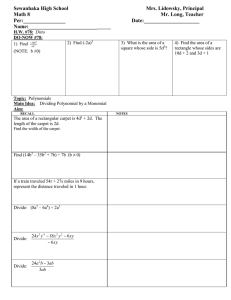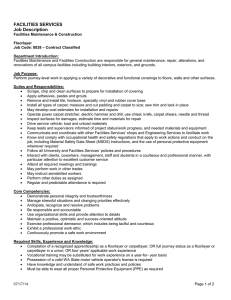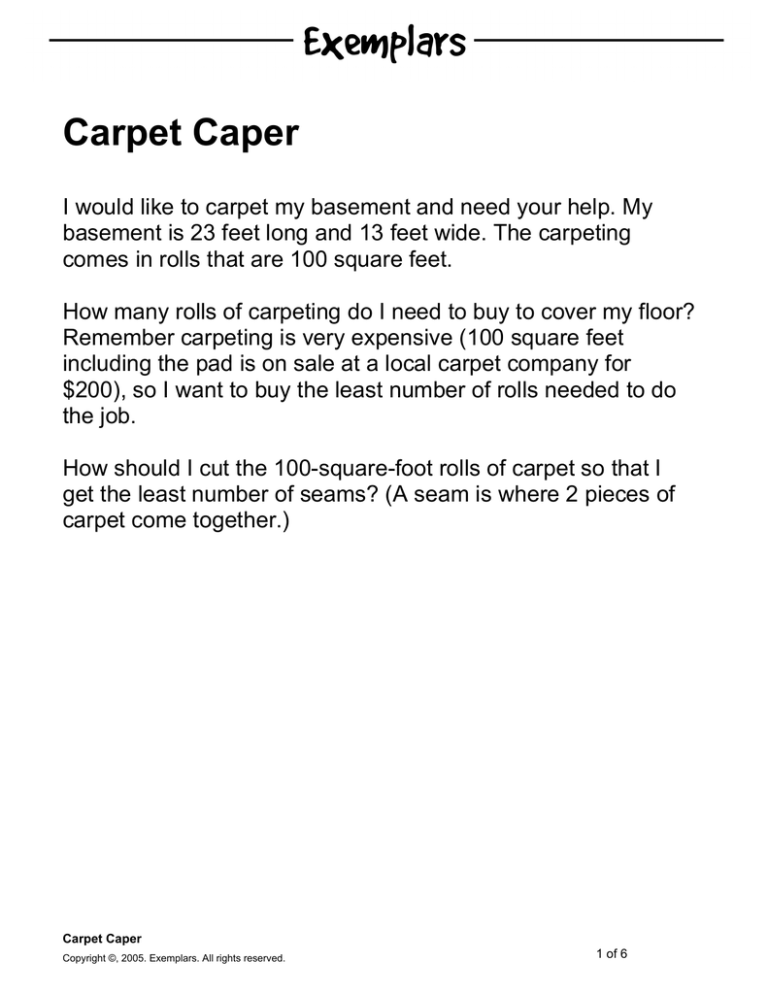
Carpet Caper
I would like to carpet my basement and need your help. My
basement is 23 feet long and 13 feet wide. The carpeting
comes in rolls that are 100 square feet.
How many rolls of carpeting do I need to buy to cover my floor?
Remember carpeting is very expensive (100 square feet
including the pad is on sale at a local carpet company for
$200), so I want to buy the least number of rolls needed to do
the job.
How should I cut the 100-square-foot rolls of carpet so that I
get the least number of seams? (A seam is where 2 pieces of
carpet come together.)
Carpet Caper
Copyright ©, 2005. Exemplars. All rights reserved.
1 of 6
Carpet Caper
Suggested Grade Span
3-5
Task
I would like to carpet my basement and need your help. My basement is 23 feet long and 13
feet wide. The carpeting comes in rolls that are 100 square feet.
How many rolls of carpeting do I need to buy to cover my floor? Remember carpeting is very
expensive (100 square feet including the pad is on sale at a local carpet company for $200), so
I want to buy the least number of rolls needed to do the job.
How should I cut the 100-square-foot rolls of carpet so that I get the least number of seams? (A
seam is where 2 pieces of carpet come together.)
Alternate Versions of Task
More Accessible Version:
I would like to carpet my basement and need your help. My basement is 23 feet long and 13
feet wide. The carpeting comes in rolls that are 100 square feet.
What is the least number or roll of carpeting I would need to complete the job?
More Challenging Version:
I would like to carpet my basement and need your help. My basement is 23 feet long and 13
feet wide. The carpeting comes in rolls that are 100 square feet.
How many rolls of carpeting do I need to buy to cover my floor? How should I cut the 100square-foot rolls of carpet so that I get the least number of seams (a seam is where 2 pieces of
carpet come together)?
Next, gather newspaper advertisements and investigate the price of carpeting. Where can I get
the best deal? Support your conclusion mathematically.
Context
This task was presented to students following a unit on multi-digit multiplication. Students were
taught several different models of multiplication, resulting in a deeper understanding of the
process. I began by having students use Base-10 pieces to create rectangular arrays of
Carpet Caper
Copyright ©, 2005. Exemplars. All rights reserved.
2 of 6
equations. Students were then introduced to the concept more abstractly using Base-10 paper.
Next, students were shown an algebraic approach (A + B)(C + D)= Area. Finally students were
shown the more traditional algorithm. This approach better allowed students to understand how
the algorithm is derived.
What This Task Accomplishes
Not only does this task accomplish an assessment of a student's ability to perform multi-digit
multiplication in context, but it also requires them to go beyond computation and evaluate their
solutions, often by rounding to the nearest whole number of carpets. The task also assesses
spatial sense. Students need to cut the carpet resulting in the least number of seams.
This problem can be solved in many different ways, using traditional calculation, but depends
on the creation of a model and/or diagram to obtain a complete solution. The task lends itself
well to mathematical observations and the use of a wide variety of mathematical terms, symbols
and notations.
What the Student Will Do
Students will realize that three rolls of carpet are needed. The tricky part comes when figuring
how to cut the carpet. Many students are unable to realize that the 9 x 1 foot strip needs to be
cut into three 3 x 1 foot strips in order to fit in the space. Some students in my class applied
Pick's Theorem, a theorem we discovered weeks earlier when studying geoboards. Students
who applied this prior knowledge to a practical situation provided more sophisticated, verified
solutions.
Time Required for Task
1-2 hours
Interdisciplinary Links
This task could be given for a unit on careers (carpet layers). In fact one of my student's
parents was a carpet layer and was fascinated with the task. There are many children's books
with carpet as a theme and students could even write fictional stories about "magic carpets." In
art, students can weave carpets and students could study different types of carpets such as
oriental carpets or Japanese mats.
Carpet Caper
Copyright ©, 2005. Exemplars. All rights reserved.
3 of 6
Teaching Tips
After my students had worked on the problem for a while, we brainstormed together a list of
mathematical terms, symbols and notations that they might consider using when
communicating their solutions. This was posted on the wall for reference. We also brainstormed
a list of possible extensions, observations and connections students could make about their
solution. For instance, students thought of finding the total cost, total area and perimeter, as
well as noticing patterns and relationships. I required each student to address at least five of the
extensions so they could practice this skill of looking above and beyond the task for extensions
and observations.
I used the following assessment for grading purposes:
Criteria:
Understood the Problem
Chose an appropriate strategy - 5 possible points
Understood both parts (# rolls and # seams) - 5 possible points
Decision Making
Correct - 5 possible points
Verifies solution by solving two ways - 10 possible points
Gives reasons - 5 possible points
Math Representation
Appropriate - 5 possible points
Accurate and descrptive title - possible 5 points
Communicates clearly - possible 5 points
Labels and keys where necessary - possible 5 points
Math Language
Variety of terms, symbols and notation - possible 7 points
Relied on to comunicate - possible 5 points
Accurate - possible 8 points
Extensions, Observations, Generalizations, "I noticed..."
Must have five. (four pints each) You have #____ - possible 20 points
Overall Presentation
Detailed - possible 3 points
Organized - possible 3 points
Neat - possible 2 points
All parts connected - possible 2 points
Total points = 100
Carpet Caper
Copyright ©, 2005. Exemplars. All rights reserved.
4 of 6
Suggested Materials
• Base-10 pieces
• Base-10 paper
• Calculators
• Yard sticks
• Markers
• Stencils
• Sticky notes
Possible Solutions
There would be three rolls of carpet with one square foot of carpeting left over.
More Accessible Version Solution:
23 x 13 = 299 square feet
Three rolls of carpet are needed with one square foot left over.
More Challenging Version Solution:
There would be three rolls of carpet with one square foot of carpeting left over.
When assessing the additional aspects of the task, consider the accuracy in student
computations and mathematical reasoning.
Task Specific Assessment Notes
Novice
A solution that shows a limited understanding of the problem and/or shows no attempt of how to
begin. Work shows little evidence of leading to an appropriate solution.
Apprentice
A solution that shows partial understanding of the problem (either understanding that the
number or rolls or the number of seams is needed). A solution that shows appropriate use of
numbers, but has a weak or random explanation of the strategy used to achieve the solution.
Practitioner
A solution that demonstrates understanding of both aspects of the problem (number of rolls and
number of seams). A solution that demonstrates appropriate equations (29 x 13), has a correct
solution and has a described strategy.
Expert
A solution that shows a sophisticated interpretation of the problem and/or experiments
successfully to create multiple solutions. For instance, the student who can interpret 100 square
Carpet Caper
Copyright ©, 2005. Exemplars. All rights reserved.
5 of 6
feet in more than one way (10 x 10 and 50 x 2). A solution that generalizes from a previous
mathematical experience (For instance, the student who multiplies 29 x 13 = 299, then divides
299 by 100 to get 2.99 rolls of carpet needed, then interprets the remainder.).
Carpet Caper
Copyright ©, 2005. Exemplars. All rights reserved.
6 of 6

